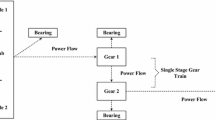Abstract
This paper addresses the problem of bond graph methodology as a graphical approach for the modeling of wind turbine generating systems. The purpose of this paper is to show some of the benefits the bond graph approach has, in contributing a model for wind turbine systems. We will present a nonlinear model of a wind turbine generating system, containing blade pitch, drive train, tower motion and generator. All which will be modeled by means of bond graph. We will especially focus on the drive train, and show the difference between modeling with a classical mechanical method and by using bond graph. The model consists of realistic parameters, but we are not trying to validate a specific wind turbine generating system. Simulations are carried out in the bond graph simulation software 20-sim [1].
Similar content being viewed by others
References
C. Kleijn, 20-sim 4.1 Reference manual, Enschede: Controllab Products B. V. (2009).
J. Tamura, T. Yamajaki, M. Ueno, Y. Matsumura and S. Kimoto, Transient stability simulation of power system including wind generator by PSCAD/EMTDC, IEEE Porto Power Tech Conference (2001).
G. Tapia, A. Tapia, I. Zubia, X. Ostolaza and J. R. Saenz, Electrical fault simulation and dynamic response of a wind farm, International Conference on Power and Energy Systems (2001).
T. Petru and T. Thiringer, Modeling of wind turbines for power system studies, IEEE Transactions on Power Systems, 17(4) (2002) 1132–1139.
V. Akhmatov and H. Knudsen, Modeling of windmill induction generators in dynamic simulation program, International Conference on Electric Power Engineering (1999).
P. Ledesma, E. Agneholm, M. Martins, A. Perdana and O. Carlson, Validation of fixed speed wind turbine dynamic models with measured data, Renewable Energy, 32(8) (2007) 1301–1316.
S. Muyeen, M. Ali, R. Takahashi, T. Murata, J. Tamura, Y. Tomaki, A. Sakahara and E. Sasano, Comparative study on transient stability analysis of wind turbine generator system using different drive train models, IET Renewable Power Generation, 1(2) (2007) 131–141.
T. J. Larsen, How 2 HAWC2, the user’s manual, Risø-R-1597(ver.3–9)(EN) (2009).
C. L. Bottasso and A. Croce, Cp-Lambda user manual, Dipartimento di Ingnegneria Aerospaziale, Politecnico di Milano (2009).
J. Jonkman and M. L. Buhl, FAST User’s Guide, Technical Report NREL/EL-500-38230 (2009).
MATLAB. version 7.10.0 (r2010a), Natick, Massachusetts: The MathWorks Inc. (2010).
P. Brath, K. Hammerum and N. K. Poulsen, A fatigue approach to wind turbine control, Journal of Physics: Conference Series, 75(1) (2007).
D. M. Eggleston and F. S. Stoddard, Wind Turbine Engineering Design, New York: Van Nostrand Reinhold Co. (1987).
H. M. Paynter, Analysis and Design of Engineering Systems, MIT Press (1961).
D. L. Margolis, D. C. Karnopp and R. C. Rosenberg, System Dynamics: Modeling and Simulation of Mechatronic Systems, John Wiley and Sons Ltd. (2006).
W. Borutzky, Bond Graph Methodology: Development and Analysis of Multidisciplinary Dynamic System Models, Springer (2010).
E. Pedersen og H. Engja, Mathematical Modeling and Simulation of Physical Systems, Lecture notes in course TMR4275 Modeling, Simulation and Analysis of Dynamic Systems at NTNU, Trondheim, Norway (2003).
L. C. Henriksen, Model predictive control of a wind turbine, Master thesis, Technical University of Denmark (2007).
S. Heier, Grid Integration of Wind Energy Conversion Systems, John Wiley and Sons Ltd. (1998).
Author information
Authors and Affiliations
Corresponding author
Additional information
Recommended by Associate Editor Yang Shi
Tore Bakka was born in Haugesund, Norway, in 1983. He earned his B.S. degree in Electrical Engineering at the University of Stavanger in 2007 and his M.S. degree in Mechatronics at the University of Agder in 2010. Currently, he is pursuing a Ph.D. degree at the University of Agder, working mainly with wind turbine control.
Hamid Reza Karimi, born in 1976, is a Professor in Control Systems at the Faculty of Engineering and Science of the University of Agder in Norway. His research interests are in the areas of networked control systems, robust control/filter design and vibration control with an emphasis on applications in engineering. Dr. Karimi is a senior member of IEEE and serves as chairman of the IEEE chapter on control systems at IEEE Norway section. He is also serving as an editorial board member for some international journals, such as Mechatronics, Information Sciences, Neurocomputing, etc.
Rights and permissions
About this article
Cite this article
Bakka, T., Karimi, H.R. Bond graph modeling and simulation of wind turbine systems. J Mech Sci Technol 27, 1843–1852 (2013). https://doi.org/10.1007/s12206-013-0435-x
Received:
Revised:
Accepted:
Published:
Issue Date:
DOI: https://doi.org/10.1007/s12206-013-0435-x




